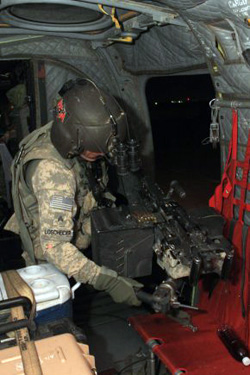National Guard Chinook crews’ contributions vital during drawdown
By Army National Guard Spc. Darriel Swatts
California National Guard

Army Sgt. Joe Loscheider, a flight engineer with B Company, 2-211th General Support Aviation Battalion, Minnesota National Guard, prepares to move his M240B machine gun into position prior to heading out on a mission from Camp Taji, Iraq, on Oct. 7, 2011. (U.S. Army photo) (Released)
 download hi-res photo
download hi-res photoCAMP TAJI, Iraq (11/2/11) – CH-47 Chinook helicopter crews with the Minnesota Army National Guard flew more than 1,100 hours in September, moving personnel and cargo.
The Chinooks are also providing a vital service during the Army's drawdown in Iraq.
"The Chinooks have been important any time we've had any drawdowns, repostures, or [base closings]," said Army Capt. John Allen, a staff officer with the 40th Combat Aviation Brigade. "We move anything and everything we can to help expedite the whole process. Plus, we help take a load off the C-130s and other fixed-wing assets, and oftentimes we are the sole provider of aerial assets to the bases that can't support fixed-wing aircraft."
At Camp Taji, Minnesota’s B Company, 2nd General Support Aviation Battalion, 211th Aviation Regiment, is deployed with the 1st General Support Aviation Battalion, 171st Aviation Regiment, a Georgia Army National Guard unit attached to the 40th Combat Aviation Brigade from the California Army National Guard. B Company is the only Chinook unit left in Iraq.
With a carrying capacity of 26,000 pounds, Chinooks are frequently used for troop and cargo movement throughout the theater.
"We are kind of like a moving company," said Army Sgt. Andrew Anderson, flight engineer with the 211th Aviation Regiment. "The pilots are the drivers and we are the muscle in the back getting it all done."
Chinooks are typically flown during the nighttime hours to capitalize on the additional protection offered by darkness. As a result, the 211th adopted the motto "All Night Long" from the title of a popular Lionel Ritchie tune.
At more than 98 feet long, the pilots rely heavily on flight engineers like Anderson to keep them informed about what is happening around the aircraft at all times.
Flight engineers play an integral role during CH-47 Chinook cargo helicopter flights. They are the eyes in the rear of the aircraft providing vital information to the pilots, the muscle that handles cargo, and they ensure the safety of passengers that are strapped in for the ride.
"The flight engineers in the Chinooks are really valuable," said Allen. "The amount of crew coordination that takes place between the pilots and the flight engineers is through the roof. They have instruments in the back that we can't see, so we depend on them to know what they're looking at, and then be able to articulate it to us up in the front."
With the number of CH-47 flights in Iraq, the crews are hardly the same for each mission and aircrew often find themselves flying and working with different people on each flight -- sometimes with the 40th CAB's commander, Army Col. Mitch Medigovich, also a CH-47 pilot.
"It's fun to be able to fly around with the brigade commander," said Army Sgt. Joe Loscheider, a flight engineer with the 2-211th. "He treats us like one of the guys. It's very informal; plus, it's nice to be able to just talk and have fun with the colonel."
As the mission in Iraq comes to an end and units start packing up to go home, the 211th is continuing to bring first-class service to the table until the very end.
The Chinook is a large tandem-rotor helicopter with a rotor diameter of 60 feet. It is the Army's go-to heavy lift helicopter and equipment transporter. It is able to transport 33 troops and their gear, or three pallets of cargo, or a sling load -- which is cargo suspended below the aircraft.